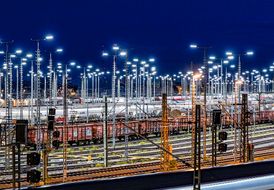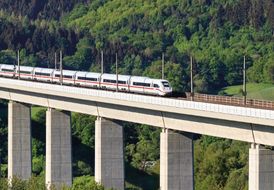European environment
DB Group
Relaunch of the Connecting Europe Facility
The new Connecting Europe Facility (CEF) Regulation (EU) 2021/1153 entered into force on July 15, 2021. The€ 33.7 billion facility for the period from 2021 to 2027 is the EU’s most important rail funding program. The transport sector has been allocated€ 25.8 billion, of which€ 11.2 billion may be requested from non-cohesion countries such as Germany. This can be used to fund infrastructure projects in order to expand cross-border connections, increase capacity and performance on existing lines and rail hubs, connect freight terminals to the TEN-T network and electrify lines. It is also used to support projects related to smart and sustainable mobility such as the European Rail Traffic Management System (ERTMS), innovations in capacity or traffic management, or the reduction of noise from rail freight transport. In addition, a further€ 1.7 billion is reserved for all 27 member states to be used on projects relating to civil and military mobility (“dual use”). The first call to apply for CEF funding was published on September 16, 2021. On the DB side, a total portfolio of 19 measures totaling about€ 3.1 billion is planned for application.Taking into account the different rates of funding (ranging between 30% and 50%), this means a potential funding amount of up to about€ 1.2 billion.
German expansion and resilience plan
To tackle the Covid-19 pandemic, the European institutions have, in addition to the multi-year financial framework, also agreed on a fixed-term crisis management instrument totaling€ 750 billion (NextGenerationEU). As part of NextGenerationEU, an expansion and resilience facility has been set up to provide member states with financial support between 2021 and 2026 totaling€ 312.5 billion for reforms and investments. To do this, member states must submit development plans with projects to the European Commission for assessment. Projects were selected for the German expansion and resilience plan (Aufbau- und Resilienzplan; DARP) on the condition that the funds available to Germany of about€ 25.6 billion would be used for projects in the economic stimulus and future readiness package. Grants have been allocated for the rail system for capital expenditures in digital signaling technology (€ 500 million) and for promotion of alternative drives in rail transport (€ 227 million). The EU Council gave the DARP its final approval on July 13, 2021. On August 26, 2021,€ 2.3 billion of preliminary financing was paid out to Germany.
The European Fit for 55 package
On July 14, 2021, the EU Commission presented a comprehensive package of legislation as part of its Green Deal. The proposed regulations are intended to achieve a 55% reduction in net greenhouse gas emissions compared to 1990 across the EU by 2030. This Fit for 55 package particularly concerns energy and transport policy. It includes, among others, proposals for a new EU emissions trading system for road traffic and buildings, stricter rules on CO₂ emissions for new approved cars and light commercial vehicles (with the result that all new vehicles approved from 2035 will need to be emissions-free), and a marginal CO₂ tax. Furthermore, free carbon trading certificates and the kerosene tax exemption for air traffic are to be gradually abolished. The proposals primarily provide opportunities for climate-friendly rail transport. They are an important step toward uniform CO₂ emissions pricing in the transport sector and a standardized internalization of external costs. The next stage for the legislative package is consultation in the Council and European Parliament. The whole Fit for 55 package is not expected to be finalized before 2023.
Trade and Cooperation Agreement
The trade and cooperation agreement between the United Kingdom and the EU entered into force with final effect on May 1, 2021.The agreement does not provide for customs duties or quotas for the trade in goods between the EU and the United Kingdom, and instead contains far-reaching regulations to guarantee fair competition. With regard to transport, the agreement provides for permanent networking in the areas of air, road and maritime transport, although market access is not at the same level as the domestic market. Rail traffic through the Channel Tunnel is secured until March 31, 2022 in line with an extension of the EU’s contingency measures which had already been approved. During that time, France and the United Kingdom are to conclude a cross-border agreement in order to secure tunnel traffic in the long term.
Infrastructure
Revision of the Regulation on EU guidelines for the expansion of the trans-European transport network
On December 14, 2021, the EU Commission submitted a proposal to revise the Trans-European Transport Network (TEN-T) guidelines. The objective, as part of the European Green Deal, is to set the course for faster completion of the multimodal TEN-T core network by 2030 in particular, and the TEN-T comprehensive network by 2050. The initiative intends to achieve this by creating a multimodal, EU-wide TEN-T network with high-quality standards. The focus is on setting up nine European transport corridors which will include TEN-T core network corridors, rail freight transport corridors and passenger transport connections. At the same time, the initiative proposes a third TEN-T level: the “extended TEN-T core network,” involving the implementation of two new technical infrastructure parameters by 2040. In view of the announced efficiency gains in links with the European rail freight transport corridors, the draft’s proposals include adjustments for more efficient governance. Following consultation by the Parliament and Council, the dossier is expected to be completed in the first half of 2023. The revision of the TEN-T guidelines is also relevant to Germany: almost one-third of the DB network is part of the TEN-T core network.
Freight transport
Revision of the Regulation concerning the creation of a European rail network for competitive freight transport
The regulation to create a European rail network for competitive freight transport, adopted in 2010, was the first instrument to improve the operation of the most important international railway routes for freight transport both within the EU and with third countries. Nine European rail freight corridors (RFC) were created to achieve this. Central sales structures, products and committee structures were also established to manage the corridors. A further two RFC were added in 2017 and 2018. Six of the now 11 European RFC run through Germany. The corridors are being developed further in order to implement the European Green Deal and the EU Commission’s Sustainable and Smart Mobility Strategy. An initiative with proposals for operating the rail freight transport corridors is planned for late 2022. The focus is in part on increasing efficiency by means of a standardized international approach to optimized capacity utilization and allocation as part of digitalized processes. Cross-border operational processes are to be harmonized across Europe. The mandatory application of scheduling standards, supported by an integrated IT system to map international train routes, is paramount.
Passenger transport
Agreement on the revision of the European Passenger Rights Regulation
The revised European Passenger Rights Regulation entered into force on June 6, 2021 and will be applicable from June 7, 2023. The new version provides that the currently applicable delay compensation levels remain unchanged (25% of the fare after one hour delay, 50% after two hours). In future, in the event of exceptional circumstances (such as extreme weather conditions, special circumstances like the Covid-19 pandemic, or for other force majeure reasons), a train operating company will be able to release itself from the obligation to pay compensation for delays.The strict obligation to provide assistance to passengers with disabilities and passengers with limited mobility is generally restricted to staffed stations. Four years after the effective date of the regulation, train operating companies s will also have to provide a mandatory number of bicycle stands when procuring new or substantially modernizing trains.



